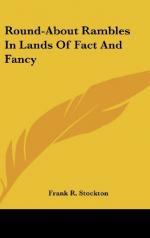[Illustration]
This is also the process of making the beautiful jug just mentioned, except that three workmen are engaged at the same time on the three parts—one blows the vase itself, another the foot, and the third the handle. They are then fastened together, and the top cut into the desired shape with shears, for glass can be easily cut when in a soft state.
You see how clearly and brightly, and yet with what softness, the windows of the room are reflected in that exquisite jug It was made only a few years ago.
I will now show you an old Venetian goblet, but you will have to handle it very carefully, or you will certainly break off one of the delicate leaves, or snap the stem of that curious flower.
Such glasses as these were certainly never intended for use. They were probably put upon the table as ornaments. The bowl is a white glass cup, with wavy lines of light blue. The spiral stem is red and white, and has projecting from it five leaves of yellow glass, separated in the middle by another leaf of a deep blue color. The large flower has six pale-blue petals.
[Illustration]
And now we will look at some goblets intended for use. They are of modern manufacture, and are plain and simple, but have a beauty of their own. The right-hand one is of a very graceful shape, and the one in the middle is odd-looking, and ingeniously made with rollers, and all of them have a transparent clearness, and are almost as thin as the fragile soap-bubbles that children blow out of pipe-bowls. They do not look unlike these, and one can easily fancy that, like them, they will melt into air at a touch.
[Illustration]
Because the ancients by some means discovered that the union of silica, lime, and soda made a perfectly transparent and hard substance it by no means follows that they knew how to make looking-glasses For this requires something behind the glass to throw back the image. But vanity is not of modern invention, and people having from the beginning of time had a desire to look at themselves, they were not slow in providing the means.
The first mirrors used were of polished metal, and for ages nobody knew of anything better. But there came a time when the idea entered the mind of man that “glass lined with a sheet of metal will give back the image presented to it,” for these are the exact words of a writer who lived four centuries before Christ. And you may be sure that glass-makers took advantage of this suggestion, if they had not already found out the fact for themselves. So we know that the ancients did make glass mirrors. It is matter of history that looking-glasses were made in the first century of the Christian era, but whether quicksilver was poured upon the back, as it is now, or whether some other metal was used, we do not know.




